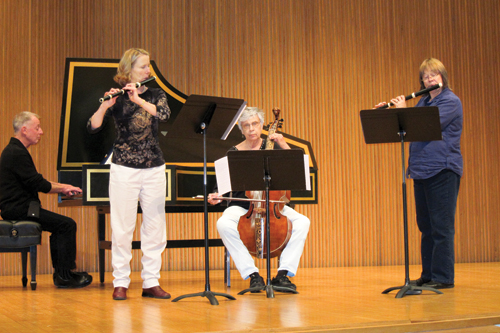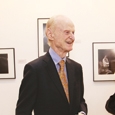.jpg)
![]()
Former students of Robert Willoughby, who taught at the Oberlin Conservatory of Music for thirty-seven years, traveled from far and wide to present a concert honoring his ninetieth birthday on Saturday, October 15 in Warner Concert Hall at Oberlin. This remarkable man, who has received The NFA’s Lifetime Achievement Award and who the British Flute Society’s journal calls the “American grandmaster of the flute,” has cast an indelible imprint on the flute world through his performing and teaching.
Willoughby represents the best tradition of American flute playing, having studied with Joseph Mariano at Eastman, Georges Laurent at the New England Conservatory, and William Kincaid in summers. He was assistant principal flute in the Cleveland Orchestra from 1946 to 1955 and principal flute of the Cincinnati Symphony for the 1959-1960 season. A longtime member of the Oberlin Woodwind Quintet, he was a founding member of the Oberlin Baroque Ensemble and teacher at Oberlin’s Baroque Perfor-mance Institute. One of the first Americans to pick up the Baroque flute in the early 1970s, he met the leaders of the Early Music movement, including Franz Vester, Barthold Kuijken, Gustav Leonhardt, and his good friend August Wenziger. He built a world-class collection of early flutes, including some that have served as models for present-day makers. As a soloist, he has a wide range of repertoire and has commissioned new works by Easley Blackwood and Thea Musgrave. Willoughby made many fine recordings on LP, some of which have been rereleased on CD. His recording of Frank Martin’s Ballade, featuring the composer at the piano, is certainly the definitive one.
In addition to his long career at Oberlin, Willoughby has taught at the Peabody Institute in Baltimore and at the Longy School of Music in Boston. His students play in nearly every major orchestra in the United States and teach at universities throughout the world. Some are leading specialists on the flauto traverso, in new music groups, and in jazz. They all remember his high standards and fast pace, sense of humor (a trait that has rubbed off on his students), love of life (especially food and wine), good taste, and insistence that musicianship trumps technical display.
The key to Bob’s teaching success is that he encourages students to think as he asks such probing questions as “Where are you going with that phrase?” “Why did you stretch that note?” “How would you make this phrase sound different from the last one?” The result is that his students achieve independence. There is no single Willoughby style or tone.
A lesson with Willoughby is never a dry rendition of technical exercises; instead, every moment is infused with musicianship. He approaches etudes as music, discussing phrasing, style, and expression. His favorite studies, Andersen’s Opus 15, Karg-Elert’s Caprices, and Jeanjean’s Etudes Modernes, stand up as good pieces, not just technical tortures.
Bob upholds high standards of repertoire. He enjoys a wide range of music, above all, Bach, Handel, French Baroque pieces, Gaubert, and contemporary music. He has no use for pieces without substance and is often impatient with contemporary works that go on too long. He does not teach many of the technical showpieces that are staples of other flutists’ repertoire. Playing with nuance is more effective than grandstanding, and one of Willoughby’s most delightful recordings features several of Charles Koechlin’s simple 14 Pieces on a compilation released by the National Flute Association; his phrasing is exquisite.
Willoughby’s use of a relaxed embouchure is famous. Many of his students spend the first few months in transition from a tighter embouchure to one that uses relaxed cheeks via the “rabbit exercise.” In front of a mirror, one practices bringing the upper lip straight up and down while keeping the lower one spread out on the lip plate, without pulling back into a smile. When the lip comes down, the student practices a tongueless attack. This exercise transfers the focus of the tone from the corners of the mouth to the center of the lips. The end result is increased resonance, a lack of harshness in the upper register, more control of intonation, and more flexible dynamics.
Variety is a theme of his teaching. He often says, “Chocolate is very good, but you can’t eat it all of the time.” He counsels his students to vary the speed and amplitude of vibrato and at times employ no vibrato, rather than using the same vibrato for every note. He stresses the importance of stylistic variety, using entirely different tone color, vibrato, dynamic range, articulation, and rhythmic freedom for Bach, Schubert, and Berio. Because the flute tends to be a monochromatic instrument, his preference for programming is to mix diverse repertoire and instrumentation; many of his solo recitals have included chamber music.

The October 15 program exemplified Willoughby’s emphasis on variety and the vast reach of his influence. It featured performances on flauto traverso by Greer Ellison, Wendy Rolfe, and Jed Wentz; Klezmer music with the infectious Adrianne Greenbaum; Shulamit Ran with new music virtuoso Patricia Spencer of the Da Capo Chamber Players; Messiaen with yours truly; and Romantic and modern repertoire with the following leading orchestral flutists: Tim Day and Robin McKee of the San Francisco Symphony; Philip Dikeman, formerly of the Detroit Symphony and newly appointed to the faculty at Vanderbilt University; Mary Kay Fink of the Cleveland Orchestra; Adam Kuenzel of the Minnesota Orchestra; and Mark Sparks of the Saint Louis Symphony.






